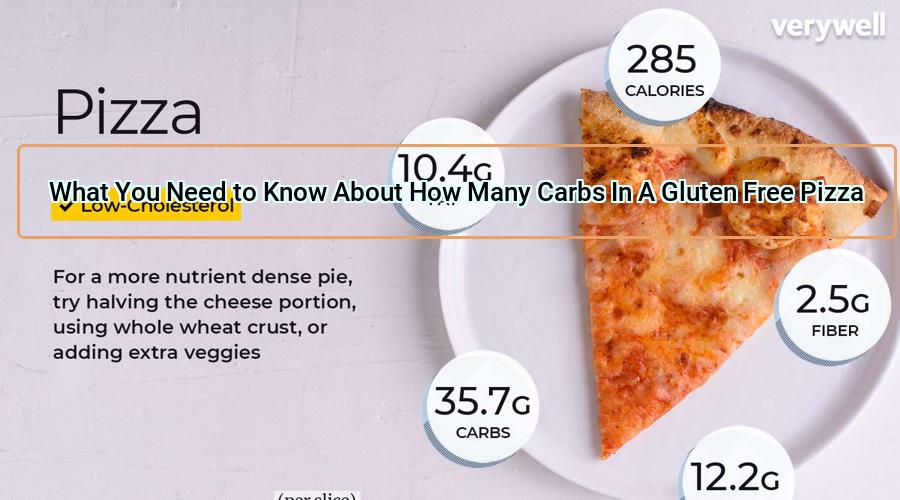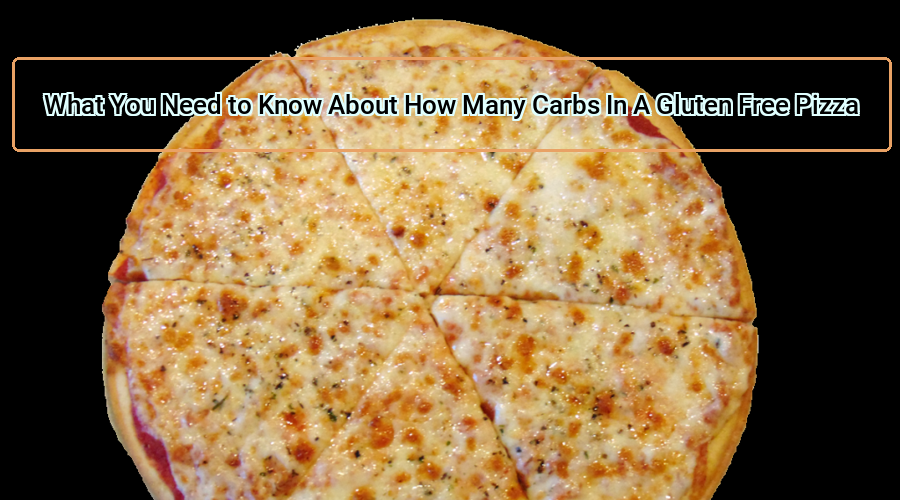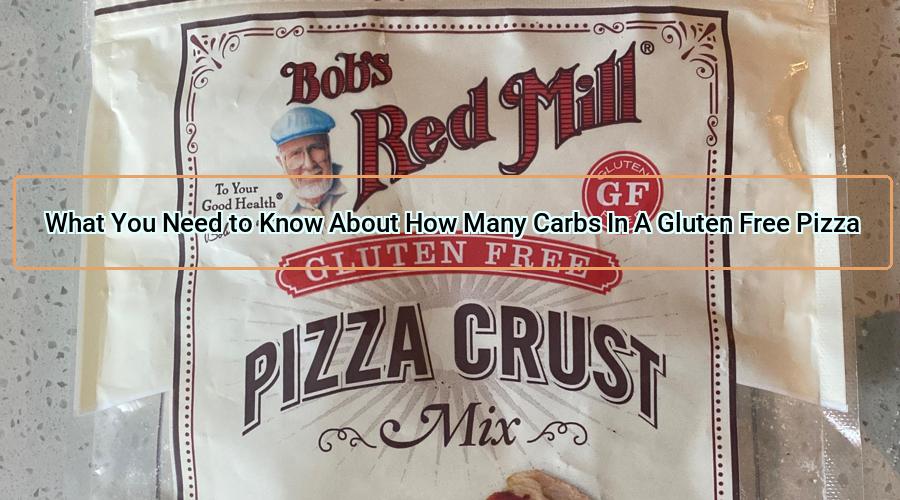When it comes to dieting, many people find themselves counting carbs. If you’re on a gluten-free diet, however, you may be wondering how many carbs are in a gluten-free pizza. Knowing the carb count of your meals is key for managing your diet and staying healthy. Here’s what you need to know about how many carbs are in a gluten-free pizza.
The number of carbs in a gluten-free pizza depends on the type of crust used and the toppings added to it. Gluten-free crusts typically contain more carbohydrates than traditional wheat flour based crusts due to their higher fiber content. On average, a slice of plain, cheese only gluten-free pizza contains around 20 grams of carbohydrates per slice depending on brand and size.
Surprising Find: Gluten Free Pizza’s Carb Content
Gluten free pizza is often seen as a healthier option for individuals with gluten sensitivities or allergies. But a new study conducted by the University of California Davis may surprise you! The research found that gluten free pizzas can actually contain higher levels of carbs than their traditional counterparts.

The findings, which were published in the American Journal of Clinical Nutrition, looked at various brands and types of both traditional and gluten free pizzas available on the market. They found that while some gluten free options had fewer total carbs than regular pizzas, others had significantly higher amounts. On average, it was determined that gluten free pizzas have around 8 grams more carbohydrates per serving size when compared to traditional versions.
These results suggest that when choosing a pizza, health-conscious individuals should look beyond just an item’s gluten status and consider its carb content as well.
Carbs in a Gluten Free Pizza: Questions Answered
Carbs in a gluten free pizza are a source of confusion for many people. For those with Celiac Disease, a gluten free diet is essential to maintaining their health. But what about the carbs? Are they healthy? Can they be part of a healthy lifestyle? To answer these questions and more, we will look at the different types of gluten free pizzas and how their carb content affects their nutritional value.
Gluten free pizza can come in many forms. Some are made with alternative grains like rice or quinoa, while others may have crusts made from almond flour or coconut flour. Additionally, some vegan options may use cauliflower-based crusts as an even healthier alternative.
A Slice of the Truth: Carbs in Gluten Free Pizza
Gluten free pizza has become a go-to for those who have to adhere to a gluten-free diet. But are the carbs in these pizzas really better than regular pizzas? Many people assume that gluten free products have fewer carbs, but this isn’t always the case. Before you reach for your next slice of gluten-free pie, take a look at what you should know about the carbs in gluten free pizza.

The truth is that while some store bought and restaurant made gluten-free pizzas have fewer calories and carbohydrates than their non-gluten counterparts, it can be hard to know what’s really in them unless you read the nutrition facts label. If you’re looking for truly low carbohydrate options, there are other alternatives that may be worth investigating – such as thin crust or cauliflower crust pizzas.
Surprising Facts about Low-Carb Gluten-Free Pizzas
Gluten-free and low carb eating has become increasingly popular recently, as many people look to switch up their diets. But did you know that you can indulge on pizza without all the guilt? Here are some surprising facts about low-carb gluten-free pizzas.
Low-carb gluten-free pizzas are made with a variety of crusts, such as almond flour or coconut flour. This means that those who have dietary restrictions due to celiac disease or diabetes can still enjoy a slice of pizza without compromising on taste. A regular medium size pizza can contain around 40 grams of carbohydrates while a low carb version will contain only 10-15 grams per serving!
Uncovering the Carb Count of a Gluten
Gluten is a protein found in grains such as wheat, rye, and barley. For those with gluten sensitivities or intolerance, determining how many carbs are in a gluten-containing food can be challenging. But understanding the carb count of a gluten is essential for anyone looking to make healthier choices or stick to their dietary restrictions.

Research suggests that one ounce of uncooked wheat flour contains about 17 grams of carbohydrates and 3 grams of fiber, resulting in 14 net carbs per ounce. Gluten-free foods typically contain fewer carbohydrates due to having fewer starches and sugars than their gluten-containing counterparts. Therefore, it’s important to know the difference between net carbs (the total carbohydrates minus the fiber) and total carbs when making decisions about what foods to include on your plate.
The nutritional information for a gluten free pizza
For those on a gluten-free diet, pizza can often be a challenge to enjoy. But with the right ingredients and preparation, it’s possible to enjoy a delicious gluten free pizza that is also healthy and nutritious.

A gluten free pizza typically contains several different types of alternative flour blends as well as vegetables, cheeses, and sauces with no gluten-containing additives. These ingredients provide important vitamins, minerals, fiber, and protein that are essential for overall health. For instance, alternative flours can be rich in B vitamins like thiamin, riboflavin, niacin and folate which are important for energy metabolism and immunity support. Vegetables provide dietary fiber which helps digestion along with an array of other micronutrients like vitamin C which aids in healing wounds.
What is the difference between a gluten free pizza and a regular pizza?
With more and more people being diagnosed with gluten sensitivities, the need for food options that are free of gluten has become increasingly important. One such option is a gluten free pizza, which is becoming easier to find in grocery stores and restaurants. But what exactly is the difference between a gluten free pizza and a regular pizza? This article will discuss the differences between these two types of pizzas, focusing on their ingredients, nutritional value, and taste.
What are some gluten free toppings for a pizza?
When it comes to pizza, everyone loves a delicious topping to add flavor and excitement. But for those with dietary restrictions due to gluten intolerance, finding tasty toppings can be a challenge. Luckily, there are gluten free alternatives that can help you make the perfect pizza without sacrificing taste. In this article, we will discuss what some of the best gluten free toppings for pizza are, so that you can enjoy a tasty meal without having to worry about compromising your health.
Is it safe to eat a gluten free pizza?
Are you considering a gluten free diet and wondering if it is safe to eat a gluten free pizza? Eating a gluten free diet is beneficial for those with Celiac Disease or wheat allergies, however the question remains: Is it safe to eat a gluten free pizza? In this article, we will look at the potential health benefits and risks associated with eating a gluten-free pizza. We will also explore some of the common ingredients found in gluten-free pizzas and their potential impact on health.

